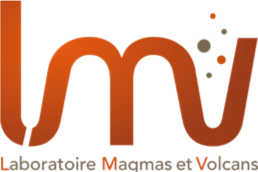The Laboratoire Magmas and volcanoes and the Institut Camille Jordan (Laboratory of Mathematics) have an open post-doctorate opportunity funded by the french research agency ANR grant The position will concern the mathematical aspects of a novel method for jointly modelling displacements and gravity variations at volcanoes. The duration of the post-doctorate is 44 months.
Scientific framework
In volcanoes, magma transfers yield deformations and gravity field variations. These can be analyzed by considering volcanoes as large heterogeneous elastic solids with fractures and magma reservoirs.
The proposed position is part of a project aiming at retrieving magma sources from two types of measurements: ground displacements (obtained via INSAR satellites) and gravity field variations (obtained via field campaigns). To do this, an efficient numerical code for the direct problem is necessary. Such a software has to enable us to compute the displacement field in the volcano (and in particular of its ground), assuming all the input data (shapes of sources and forces they apply).
The aim of this project is to improve the existing software, based on fictitious domains (Bodart et al., 2016; 2022), and then develop and test a method to perform joint inversions of sources and gravity variations.
Work program
We have developed, tested and practically validated a domain decomposition technique for the approximation of the deformation of a volcano in presence of a magmatic crack exerting a force on the global structure. The drawback of this method is that the crack has to be extended to the boundary of the computational domain. This produces two subdomains, each of them being locally on one side of its boundary. This approach prevents us to take several cracks into account. But in real life applications, several sources can be present in the volcano and they can be either cracks or reservoirs.
The post-doctoral fellow will first have to work on the improvement of the numerical method. This will need to modify the way to take a crack or a reservoir into account. Several ideas can be thought of to avoid the extension of the crack. In a second step, we will work on a method to take gravity field micro-variations into account. Then we will work on the inverse problem: identification of the sources (cracks, reservoirs) and of the force they exert on the volcanic structure, which is a topological optimization problem.
Required skills
- Analysis of partial differential equations, optimization, optimal control
- Numerical methods: finite element method, fictitious domains, domain decomposition
- Programming skills: C++, Python, Matlab
Research team
- Olivier Bodart, Institut Camille Jordan, Université Jean Monnet (olivier.bodart@univ-st-etienne.fr)
- Pierre-Henri Cocquet, Laboratoire des sciences pour l’ingénieur appliquées à la mécanique et au génie électrique, UPPA, Pau (pierre-henri.cocquet@univ-pau.fr)
- Valérie Cayol, Laboratoire Magmas et Volcans, Université Clermont-Auvergne (valerie.cayol@uca.fr)
- Jonas Koko, LIMOS, Université Clermont-Auvergne (jonas.koko@uca.fr)


